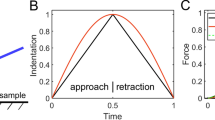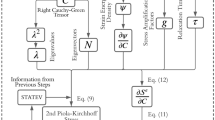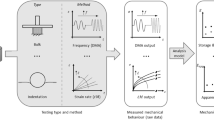Abstract
In this study, we theoretically investigate the dynamic indentation for measuring the loss (damping) factor of a linear viscoelastic material from its indentation response. A rigid indenter with arbitrary tip profile is assumed to indent into a viscoelastic substrate with arbitrary shape. We perform a theoretical analysis and identify the conditions under which the loss factor of the material can be determined from the phase angle between the applied harmonic indentation load and the corresponding harmonic displacement, a directly measurable quantity in a dynamic indentation test. To validate the conclusion drawn from our theoretical analysis, a series of numerical experiments are performed, including the spherical indentation of a soft layer with irregular surface morphology bonded to a rigid substrate, a conical indenter with tip defects indenting into a half-spherical particle, and the indentation of porous materials. This study may facilitate the use of the dynamic indentation technique to evaluate the damping properties of linear viscoelastic materials, including some advanced polymers and biological soft tissues.
Similar content being viewed by others
References
Suhr J, Koratkar N, Keblinski P, et al. Viscoelasticity in carbon nanotube composites. Nat Mater, 2005, 4: 134–137
Levental I, Georges P C, Janmey P A. Soft biological materials and their impact on cell function. Soft Matter, 2007, 3: 299–206
Lee B, Han L, Frank E H, et al. Dynamic mechanical properties of the tissue-engineered matrix associated with individual chondrocytes. J Biomech, 2010, 43: 469–476
Shimizu S, Yanagimoto T, Sakai M. Pyramidal indentation load-depth curve of viscoelastic materials. J Mater Res, 1999, 14: 4075–4086
Fischer-Cripps A C. Nanoindentation. New York: Springer, 2002
Lu H, Wang B, Ma J, et al. Measurement of creep compliance of solid polymers by nanoindentation. Mech Time-Depend Mater, 2003, 7: 189–207
Cheng Y T, Cheng C M. Scaling, dimensional analysis, and indentation measurements. Mater Sci Eng R, 2004, 44: 91–149
Ngan A H W, Wang H T, Tang B, et al. Correcting power-law viscoelastic effects in elastic modulus measurement using depth-sensing indentation. Int J Solids Struct, 2005, 42: 1831–1846
Ebenstein D M, Pruitt L A. Nanoindentation of biological materials. Nano Today, 2006, 1: 26–33
Vandamme M, Ulm F J. Viscoelastic solutions for conical indentation. Int J Solids Struct, 2006, 43: 3142–3165
Constantinides G, Kalcioglu Z L, McFarland M, et al. Probing mechanical properties of fully hydrated gels and biological tissues. J Biomech, 2008, 41: 3285–3289
Cheng Y T, Yang F Q. Obtaining shear relaxation modulus and creep compliance of linear viscoelastic materials from instrumented indentation using axisymmetric indenters of power-law profiles. J Mater Res, 2009, 24: 3013–3017
Oyen M L, Cook R F J. Load-displacement behavior during sharp indentation of viscous-elastic-plastic materials. J Mater Res, 2003, 18: 139–150
Oyen M L. Spherical indentation creep following ramp loading. J Mater Res, 2005, 20: 2094–2100
Oyen M L. Sensitivity of polymer nanoindentation creep measurements to experimental variables. Acta Mater, 2007, 55: 3633–3639
Cao Y P, Ma D C, Raabe D. The use of flat punch indentation to determine the viscoelastic properties in the time and frequency domains of a soft layer bonded to a rigid substrate. Acta Biomater, 2009, 5: 240–248
Nashif A D, Jones D I G, Henderson J P. Vibration Damping. New York: Wiley, 1985
Corsaro R D, Sperling L H. Sound and Vibration Damping with Polymers. Washington DC: American Chemical Society, 1990
Cao Y P, Ji X Y, Feng X Q. Geometry independence of the normalized relaxation functions of viscoelastic materials in indentation. Phil Mag, 2010, 90: 1639–1655
Lucas B N, Oliver W C, Swindeman J E. The dynamics of frequency-specific, depth-sensing indentation testing. In: Moody N R, Gerberich W W, Burnham N, et al., eds. Materials-Research-Society Symposium on Fundamentals of Nanoindentation and Nanotribology. San Francisco: Materials Research Society, 1998. 522: 3–14
Loubet J L, Oliver W C, Lucas B N. Measurement of the loss tangent of low-density polyethylene with a nanoindentation technique. J Mater Res, 2000, 15: 1195–1198
Fischer-Cripps A C. Multiple-frequency dynamic nanoindentation testing. J Mater Res, 2004, 19: 2981–2988
Cheng Y T, Ni W Y, Cheng C M. Nonlinear analysis of oscillatory indentation in elastic and viscoelastic solids. Phys Rev Lett, 2006, 97: 075506
Huang G, Wang B, Lu H. Measurements of viscoelastic functions of polymers in the frequency-domain using nanoindentation. Mech Time-Depend Mater, 2004, 8: 345–364
Herbert E G, Oliver W C, Pharr G M. Nanoindentation and the dynamic characterization of viscoelastic solids. J Phys D-Appl Phys, 2008, 41: 074021
Herbert E G, Oliver W C, Lumsdaine A, et al. Measuring the constitutive behavior of viscoelastic solids in the time and frequency domain using flat punch nanoindentation. J Mater Res, 2009, 24: 626–637
Christensen R M. Theory of viscoelasticity: An introduction. New York: Academic Press, 1982
Cao Y P. Determination of the creep exponent of a power-law creep solid using indentation tests. Mech Time-Depend Mater, 2007, 11: 159–172
ABAQUS User’s Manual, Version 6.5.1. Providence: Hibbit, Karlsson & Sorenson, 2006
Huang G, Lu H B. Measurement of Young’s relaxation modulus using nanoindentation. Mech Time-Depend Mater, 2006, 10: 229–243
Tan E P S, Lim C T. Mechanical characterization of nanofibers—A review. Compos Sci Technol, 2006, 66: 1102–1111
Author information
Authors and Affiliations
Corresponding author
Rights and permissions
About this article
Cite this article
Cao, Y., Ji, X. & Feng, X. On determination of the damping factor of linear viscoelastic materials using dynamic indentation: a theoretical study. Sci. China Phys. Mech. Astron. 54, 598–605 (2011). https://doi.org/10.1007/s11433-011-4279-z
Received:
Accepted:
Published:
Issue Date:
DOI: https://doi.org/10.1007/s11433-011-4279-z




